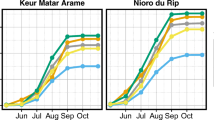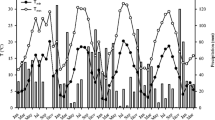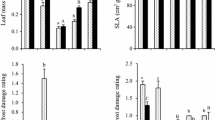Abstract
Performance of two rhizomatous crops i.e. ginger (Zingiber officinale Rosc.) and turmeric (Curcuma longa L.) was investigated under rainfed conditions in pure stands and as intercrops with 5-year-old poplars planted at three spacings viz., 5×5 m, 5×4 m and 5×3 m. The average illumination below the canopies was 53, 46 and 38% of incident radiation, respectively. Both crops performed better as intercrops than as pure stands. Survival was inversely correlated to light intensity. Plant height, tillers per plant and leaves per plant in ginger and leaf length and leaf breadth besides plant height in turmeric were significantly enhanced when intercropped. The rhizome length, rhizome breadth, yield per plant and yield per ha in ginger exceeded under poplars but showed a drastic reduction under the closest poplar spacing. In turmeric, the trend for the first two characters was the same, whereas yield per plant as well as yeild per ha were slightly greater in the open than under 5×3 m spacing. Dry matter content varied significantly with spacing. For quality parameters, only oil content in ginger and oleoresin in turmeric showed significant differences. The cultivation of turmeric proved more remunerative than ginger.
Among the poplar spacings, 5×4 m for ginger and 5×5 m for turmeric were delineated as the best spacings.
Similar content being viewed by others
References
Aclain F and Cuisumbing EC (1976) Fertilizer, mulch and light attenuation on the yield and quality of Ginger. Philippine Agriculturist 60(5/6): 183–191
AOAC (1980) Official Methods of Analysis, 13th ed. Association of Official Analytical Chemists, Washington, DC
Blackman GE and Wilson GL (1951) Physiological and ecological studies in the analysis of plant environment VI. The constancy for different species of a logarithmic relationship between net assimilation rate and light intensity and its ecological significance. Ann Bot 15: 67
Lahiri AK (1972) Intercropping trials with Turmeric in North Bengal. Ind For 98: 109–115
Lalitha Bai EK (1981) Shade response of common rainfed intercrops of coconut. M.Sc. (Agri.) Thesis, Kerala Agri. Univ. Thrissur, Kerala, India
Marwaha S (1984) Propagation studies in Ginger. M.Sc. Thesis, HPKVV, Palampur, India, 44 pp
Nair PCS (1980) Agronomy of Ginger and Turmeric. In: The proceedings of the National Seminar on Ginger and Turmeric, pp 63–68. CPCRI, Calicut, India
Nair PKR (1979) Intensive Multiple Cropping with Coconuts in India: Principles, Programmes and Prospects. Verlag Paul, Parey, Berlin, 147 pp
Natarajan CP, Padmabai R, Krishnamurthy MN, Raghavan BR, Sankaracharya NB, Kuppuswamy S, Govindrajan VS and Lewis YS (1972) Chemical composition of Ginger varieties and dehydration studies on Ginger. J Food Sci Technol, India 9: 120–124
Neopaney B (1988) Effect of different levels of (NPK) essential elements and spacing on growth and yield of Ginger (Zingiber officinale Rosc.). M.Sc. Thesis, Dr. Y. S. Parmar University of Horticulture and Forestry, Solan, H. P., India, 49 pp
Purseglove JW, Brown EG, Green GL and Robbins SRJ (1981) Spices, Vol 2. Longman Inc, New York, 813 pp
Safania S, Chandra S and Etherington DM (1982) A review of recent research on intercropping under Coconuts. Fiji Agric J 44: 31–36
Satheesan KV and Ramadasan A (1980) Growth and productivity of Turmeric grown as a pure and as an intercrop in Coconut garden. In: The proceedings of the National Seminar on Ginger and Turmeric, pp 69–75. CPCRI, Calicut, India
Singh RK, Bhalerao MM and Reddy MJM (1986) Costs and returns of intercrops in Arecanut. Ind Cococa, Arecanut and Spices J 9(4): 99
Thangaraj T, Muthuswamy S, Muthukrishanan CR and Khader JBMMA (1983) Performance of Ginger (Zingiber officinale Rosc.) varieties of Coimbatore. South Ind Hort 31: 45–46
Author information
Authors and Affiliations
Rights and permissions
About this article
Cite this article
Jaswal, S.C., Mishra, V.K. & Verma, K.S. Intercropping ginger and turmeric with poplar (Populus deltoides ‘G-3’ Marsh.). Agroforest Syst 22, 111–117 (1993). https://doi.org/10.1007/BF00705140
Issue Date:
DOI: https://doi.org/10.1007/BF00705140




